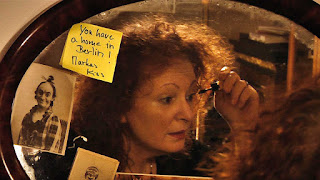 The best thing about Sabine Lidl’s captivating documentary on the celebrated photographer Nan Goldin is that she so perfectly captured the brutal honesty of both the woman and her work. Since the 1970’s Goldin has been photographing unfiltered raw shocking images of addiction, desire and sexuality but unlike her peers these were not of models or random subjects but the people that were a close part of her life. This was the life that she led, and these were her friends who became her family too.
The best thing about Sabine Lidl’s captivating documentary on the celebrated photographer Nan Goldin is that she so perfectly captured the brutal honesty of both the woman and her work. Since the 1970’s Goldin has been photographing unfiltered raw shocking images of addiction, desire and sexuality but unlike her peers these were not of models or random subjects but the people that were a close part of her life. This was the life that she led, and these were her friends who became her family too.
She rebelled from her nice middle-class Jewish home in a Washington suburb where she was brought up and where her elder sister took her own life when Goldin was just 11 years. She mentions this in passing in the film and without even going into any detail, it is clear that it had a profound effect on her. Goldin clearly dislikes being in front of a camera but Lidl shot the whole thing on her own with no crew and simply followed her around for a few months from country to country. The result is that this is more of an intimate portrait than a detailed biography, which is the perfect format to tell this story.
They talk about when Goldin left school and enrolled at Tufts University to do a photography class and that’s when she first met one of her best friends David Armstrong a budding photographer who had just started to do drag. He introduced her to the demi-monde world of Boston’s gay and drag communities where she immediately felt at home. These, she claimed, were her people and was the start of many close friendships which only ended when the AIDS crisis claimed so many of their lives. She moved in with them and photographed them all, respecting their sexuality (her own was quite fluid) although that didn’t stop her falling in love with them, and quite often. She started what would remain the central ethos of her photography and art, that she was an integral part of it and not just a voyeur on any level.
What Lidl captures now is Goldin in her 60’s flitting from Berlin to Paris or New York the three cities she lives in and where her work is constantly being shown. At each stop she encounters ex-lovers who she still shares extraordinary close connections with and who are still an integral part of her life. She radiates such a strong positive aura with a zest for life and a need to flirt outrageously as often as she possibly can, which is great contrast to the reality that the main body of her extensive catalogue of work is full of sadness, melancholy and death.
 Goldin is never less than disarmingly frank when she talks about some of the rougher passages of her life ‘when I was addicted to cocaine, I didn’t leave my house for one whole year. Taking drugs became a full time job’. It’s said not to evoke criticism or in fact any kind of comment, but it somehow helps explain the sheer intensity of some of her more controversial pieces, and why for example that way before Kate Moss, Goldin was credited with the real start of heroin chic.
Goldin is never less than disarmingly frank when she talks about some of the rougher passages of her life ‘when I was addicted to cocaine, I didn’t leave my house for one whole year. Taking drugs became a full time job’. It’s said not to evoke criticism or in fact any kind of comment, but it somehow helps explain the sheer intensity of some of her more controversial pieces, and why for example that way before Kate Moss, Goldin was credited with the real start of heroin chic.
Lidl frames her film with some of Goldin’s famous slide shows which unquestionably contain some of her very best work. Not simply because of the sheer horrific powerful graphic images of her self-inflicted cigarette burns or when one of her boyfriends beat her up etc. it’s the unshakable knowledge knowing that this was/is her real life.
The work has often been called controversial, and maybe taken out of context some of it is. However what you cannot fail to appreciate by the end of this profile is that it is the work of a sheer genius, and a very brave and passionate one to boot. If you are unfamiliar with Goldin’s work, then this is a great place to start. If you are already a fan then you will want much more than this mere 62 minutes as there is a wealth of art we still need to see, and a whole history we still need to hear.


